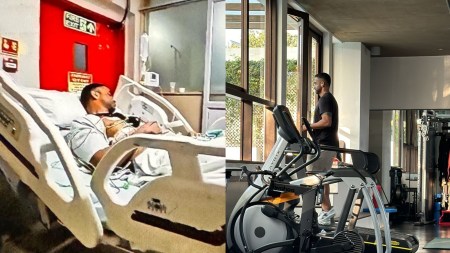Beat post-flight stiffness with 3 simple stretches
After enduring the discomforts of a long flight, your body may feel stiff, cramped, and fatigued. Fortunately, simple movements can help alleviate tension, improve circulation, and promote relaxation. Whether you’re a frequent flyer or embarking on your first trip, incorporating these stretches into your post-flight routine can revitalise your body and enhance your travel experience, courtesy celebrity fitness instructor Yasmin Karachiwala.
Cat and Cow
Cat and Cow stretch is a gentle yoga movement that helps to warm and mobilise the spine, shoulders and hips. It helps promote flexibility and mobility in the upper body, relieve tension and improve posture.

Steps:
1. Begin standing tall with your feet hip-width apart and your arms relaxed at your sides.
2. Inhale deeply as you sweep your arms out to the sides. Allow your chest to lift, and gently arch your back as you look towards your hands. This is the “cow” position.
3. Hold the stretch for a moment, feeling the gentle opening across your chest and the lengthening of your spine.
4. Exhale slowly as you round your spine, bringing your arms down towards the floor and tucking your chin towards your chest. Draw your belly button towards your spine and imagine rounding your back like a Halloween cat. This is the “cat” position.
5. Hold the stretch for a moment, feeling the contraction of your abdominal muscles and the gentle release of tension in your upper back and shoulders.
6. Move with your breath as you flow between the Standing Cat and Cow Poses. Inhale as you lift into Cow Pose, and exhale as you round into Cat Pose.
7. Repeat for several rounds, moving mindfully and smoothly, and focusing on the rhythm of your breath and the sensation in your body.
View this post on Instagram
A post shared by Yasmin Karachiwala | Celebrity Fitness Instructor (@yasminkarachiwala)
Thoracic Contraction and Extension
Also known as thoracic mobility exercises, these movements are designed to improve flexibility, strength, and range of motion in the thoracic spine — the middle portion of the vertebral column between the cervical (neck) and lumbar (lower back) regions. These exercises are beneficial for individuals looking to alleviate stiffness, enhance posture, and reduce the risk of back pain.
Steps:
1. Begin by sitting or standing tall with your back straight and shoulders relaxed.
2. Place your hands behind your head, interlacing your fingers or clasping them together.
3. Inhale deeply to prepare.
4. As you exhale, gently contract your abdominal muscles and round your upper back, bringing your elbows towards each other in front of your chest.
5. Imagine bringing your ribcage towards your pelvis, creating a C-shape curve with your spine.
6. Hold the contraction for a few seconds, feeling the stretch along your upper back and between your shoulder blades.
7. Inhale as you return to the starting position with a neutral spine.
8. As you exhale, gently arch your upper back, lifting your chest towards the ceiling and squeezing your shoulder blades together.
9. Allow your head to tilt slightly upwards, maintaining a neutral position with your neck.
10. Focus on opening up through the front of your chest and expanding your ribcage.
11. Hold the extension for a few seconds, feeling the stretch along the front of your body and the activation of the muscles between your shoulder blades.
12. Inhale as you return to the starting position with a neutral spine.
13. Repeat for several repetitions, moving with controlled and deliberate movements.
Neck Rotation
 Would you try any of these stretches after your next flight? (Source: Freepik)
Would you try any of these stretches after your next flight? (Source: Freepik)
It is a simple yet effective movement that help improve flexibility and mobility in the cervical spine (neck). These exercises can help alleviate stiffness, reduce tension, and promote relaxation in the neck and shoulder muscles.
Steps:
1. Begin by sitting comfortably in a chair with your feet flat on the floor and your spine tall.
2. Start with your head in a neutral position, facing forward, and your chin parallel to the ground.
3. Inhale deeply to prepare.
As you exhale, slowly rotate your head to the right, turning your chin towards your right shoulder.
4. Keep your shoulders relaxed and avoid lifting or shrugging them as you rotate your neck.
5. Move only within your comfortable range of motion, avoiding any pain or discomfort.
6. Hold the stretch for a few seconds, feeling the gentle stretch along the left side of your neck.
7. Inhale as you return your head to the neutral position, facing forward.
8. Aim to perform 5-10 repetitions on each side, or as many as feels comfortable for you.
Disclaimer: The copyright of this article belongs to the original author. Reposting this article is solely for the purpose of information dissemination and does not constitute any investment advice. If there is any infringement, please contact us immediately. We will make corrections or deletions as necessary. Thank you.





